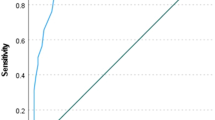Abstract
The objective of this study was to examine the level of agreement between child- and caregiver-reports of the child’s psychosocial problems presenting to a Pediatric Emergency Department (PED) using a validated screening tool. This was an anonymous, prospective, cross-sectional, multi-informant (child and caregiver) study assessing cognitive, emotional, and behavioral problems and physical complaints in children and adolescents presenting to a PED. Three-hundred and fifty-eight children and adolescents (8–18 years old) and their caregivers participated. Children completed the Youth-Pediatric Symptom Checklist (PSC-Y), while their caregivers completed the Pediatric Symptom Checklist–35 (PSC-35) to measure psychosocial impairment. The child’s physical complaints (e.g., chief complaint, chronicity, other medical problems, medications) and demographic information were assessed using an investigator-developed patient background questionnaire completed by the caregivers. Physical complaints (e.g., chief complaint, chronicity, other medical problems, medications) were assessed using an investigator-developed patient background questionnaire. Agreement between child- and caregiver- reports was analyzed using Cohen’s kappa coefficient. Differences between child and caregiver-reported scores were determined by t-tests. Poor to moderate agreement was found between child- and caregiver-reports of attention problems (κ = .355), externalizing problems (κ = .340), internalizing problems (κ = .065), and total PSC score (κ = .410). Both children and caregivers should complete the psychosocial screener to maximize the accuracy of assessment and the identification of impairment.
Similar content being viewed by others
References
Biros, M. H., Hick, K., Cen, Y. Y., Mann, J., Gaetz, A., Hansen, R., et al. (2008). Occult depressive symptoms in adolescent emergency department patients. Archives of Pediatrics and Adolescent Medicine, 162(8), 769–773.
Borowsky, I. W., Mozayeny, S., & Ireland, M. (2003). Brief psychosocial screening at health supervision and acute care visits. Pediatrics, 112(1 Pt 1), 129–133.
Cantwell, D. P., Lewinsohn, P. M., Rohde, P., & Seeley, J. R. (1997). Correspondence between adolescent report and parent report of psychiatric diagnostic data. Journal of the American Academy of Child and Adolescent Psychiatry, 36(5), 610–619.
Cronbach, L. J., & Warrington, W. G. (1951). Time-limit tests: Estimating their reliability and degree of speeding. Psychometrika, 16(2), 167–188.
Escobar, J. I., Interian, A., Diaz-Martinez, A., & Gara, M. (2006). Idiopathic physical symptoms: A common manifestation of psychiatric disorders in primary care. CNS Spectrums, 11(3), 201–210.
Gold, J. I., Mahrer, N. E., Yee, J., & Palermo, T. M. (2009). Pain, fatigue and health-related quality of life in children and adolescents with chronic pain. Clinical Journal of Pain, 25(5), 407–412.
Jellinek, M. S., Murphy, J. M., & Burns, B. J. (1986). Brief psychosocial screening in outpatient pediatric practice. The Journal of Pediatrics, 109(2), 371–378.
Jellinek, M. S., Murphy, J. M., Robinson, J., Feins, A., Lamb, S., & Fenton, T. (1988). Pediatric symptom checklist: Screening school-age children for psychosocial dysfunction. The Journal of Pediatrics, 112(2), 201–209.
Jellinek, M. S., Bishop, S. J., Murphy, J. M., Biederman, J., & Rosenbaum, J. F. (1991). Screening for dysfunction in the children of outpatients at a psychopharmacology clinic. The American Journal of Psychiatry, 148(8), 1031–1036.
Jensen, P. S., Rubio-Stipec, M., Canino, G., Bird, H. R., Dulcan, M. K., Schwab-Stone, M. E., et al. (1999). Parent and child contributions to diagnosis of mental disorder: Are both informants always necessary? Journal of the American Academy of Child and Adolescent Psychiatry, 38(12), 1569–1579.
Jozefiak, T., Larsson, B., Wichstrom, L., Mattejat, F., & Ravens-Sieberer, U. (2008). Quality of life as reported by school children and their parents: A cross-sectional survey. Health and Quality of Life Outcomes, 6, 34.
Kolko, D. J., & Kazdin, A. E. (1993). Emotional/behavioral problems in clinic and nonclinic children: Correspondence among child, parent and teacher reports. Journal of Child Psychology and Psychiatry and Allied Disciplines, 34(6), 991–1006.
Murphy, J. M., Jellinek, M., & Milinsky, S. (1989). The pediatric symptom checklist: Validation in the real world of middle school. Journal of Pediatric Psychology, 14(4), 629–639.
Murphy, J. M., Reede, J., Jellinek, M. S., & Bishop, S. J. (1992). Screening for psychosocial dysfunction in inner-city children: Further validation of the pediatric symptom checklist. Journal of the American Academy of Child and Adolescent Psychiatry, 31(6), 1105–1111.
Pagano, M. E., Cassidy, L. J., Little, M., Murphy, J. M., & Jellinek, M. S. (2000). Identifying psychosocial dysfunction in school-age children: The pediatric symptom checklist as a self-report measure. Psychology in the Schools, 37(2), 91–106.
Rauch, P. K., Jellinek, M. S., Murphy, J. M., Schachner, L., Hansen, R., Esterly, N. B., et al. (1991). Screening for psychosocial dysfunction in pediatric dermatology practice. Clinical Pediatrics, 30(8), 493–497.
van der Meer, M., Dixon, A., & Rose, D. (2008). Parent and child agreement on reports of problem behaviour obtained from a screening questionnaire, the SDQ. European Child and Adolescent Psychiatry, 17(8), 491–497.
Author information
Authors and Affiliations
Corresponding author
Rights and permissions
About this article
Cite this article
Montaño, Z., Mahrer, N.E., Nager, A.L. et al. Assessing Psychosocial Impairment in the Pediatric Emergency Department: Child/Caregiver Concordance. J Child Fam Stud 20, 473–477 (2011). https://doi.org/10.1007/s10826-010-9414-3
Published:
Issue Date:
DOI: https://doi.org/10.1007/s10826-010-9414-3




